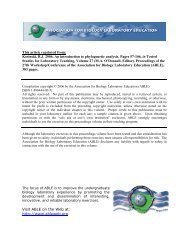A Study of Gene Linkage and Mapping Using - Association for ...
A Study of Gene Linkage and Mapping Using - Association for ...
A Study of Gene Linkage and Mapping Using - Association for ...
You also want an ePaper? Increase the reach of your titles
YUMPU automatically turns print PDFs into web optimized ePapers that Google loves.
2 Tetrad Analysis<br />
Contents<br />
Introduction ......................................................................................................2<br />
Materials...........................................................................................................3<br />
Notes <strong>for</strong> the Instructor.....................................................................................3<br />
Student Outline.................................................................................................4<br />
Literature Cited.................................................................................................21<br />
Appendix A: Student Data <strong>and</strong> <strong>Study</strong> Questions with Answers ......................22<br />
Introduction<br />
The laboratory presented here has been used in the introductory course <strong>for</strong> biology majors at<br />
Cornell University <strong>for</strong> the past 15 years. It was designed to accomplish the following objectives:<br />
1. to rein<strong>for</strong>ce knowledge <strong>of</strong> meiosis <strong>and</strong> its importance in transmission genetics,<br />
2. to introduce the concepts <strong>of</strong> gene linkage <strong>and</strong> mapping,<br />
3. to provide experience with fungal life cycle stages <strong>and</strong> with sterile methods <strong>for</strong> manipulating<br />
microorganisms,<br />
4. to illustrate the use <strong>of</strong> the chi-square statistical test <strong>for</strong> selecting between different genetic<br />
models, <strong>and</strong><br />
5. to show application <strong>of</strong> the probability laws to the study <strong>of</strong> biological problems.<br />
The fungi, especially those ascomycetes that produce isolated, ordered tetrads, have been<br />
fundamentally important to the teaching <strong>of</strong> genetics (Cassell <strong>and</strong> Mertens, 1968; Fincham, 1971).<br />
We selected the genus Sordaria over Neurospora <strong>for</strong> this study because <strong>of</strong> the absence <strong>of</strong> asexual,<br />
conidiospores in Sordaria. This reduces considerably the problem <strong>of</strong> accidental contamination <strong>of</strong><br />
cultures. S. fimicola is a species that has been extensively studied (El-Ani et al., 1961; El-Ani <strong>and</strong><br />
Olive, 1975) <strong>and</strong> <strong>for</strong> which numerous genetic markers are available. Spore color genes that have<br />
been studied in this species (Olive, 1956) are especially useful <strong>for</strong> teaching purposes because they<br />
allow tetrad analysis <strong>of</strong> intact asci <strong>and</strong> direct observation <strong>of</strong> the effects <strong>of</strong> crossing over. We chose<br />
S. fimicola over S. brevicollis, another species in this genus that has been used <strong>for</strong> teaching<br />
purposes, because S. fimicola does not undergo the spindle overlap during the second meiotic<br />
division that occurs in S. brevicollis (Chen <strong>and</strong> Olive, 1965). Spindle overlap makes tetrad analysis<br />
less direct <strong>and</strong> reduces its pedagogical effectiveness in illustrating the genetic implications <strong>of</strong><br />
meiosis. However, since S. brevicollis is a heterothallic species, all <strong>of</strong> its perithecia contain asci<br />
resulting from interstrain mating. This makes locating asci suitable <strong>for</strong> tetrad analysis easier than in<br />
S. fimicola, which is homothallic.<br />
The version <strong>of</strong> the laboratory described here involves examining the results <strong>of</strong> mating between<br />
mutant strains <strong>for</strong> two spore color genes (tan spore <strong>and</strong> gray spore) in order to map these genes <strong>and</strong><br />
determine if they are linked. The laboratory extends over 3 weeks. Students set up the cross during<br />
the first week. Asci mature during the second week <strong>and</strong> are held in the refrigerator until the third<br />
week when tetrad analysis occurs <strong>and</strong> data are shared among the class. Included in the Appendix is<br />
a set <strong>of</strong> study questions (<strong>and</strong> answers) designed to help students with the analysis <strong>and</strong> interpretation<br />
<strong>of</strong> these data. This laboratory can be accomplished in one 3-hour laboratory if the genetic cross is<br />
set up <strong>for</strong> the students about 10 days ahead <strong>of</strong> time.<br />
An alternate, simpler approach that requires more laboratory time is to have students begin with<br />
tetrad analysis <strong>of</strong> the wild type-mutant crosses (wild type × gray spore; wild type × tan spore).<br />
These data allow each gene to be mapped in isolation <strong>of</strong> the other gene. This is then followed by
















